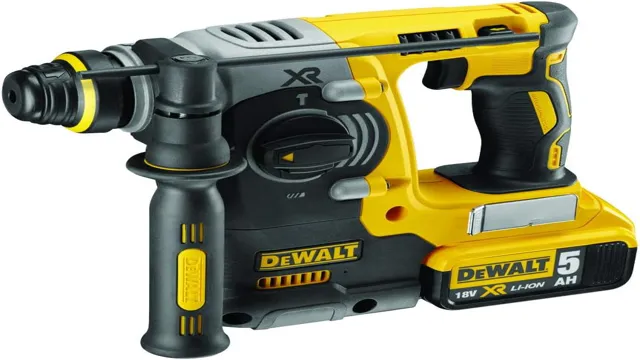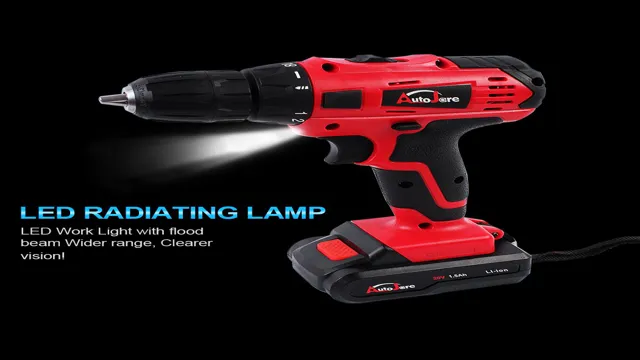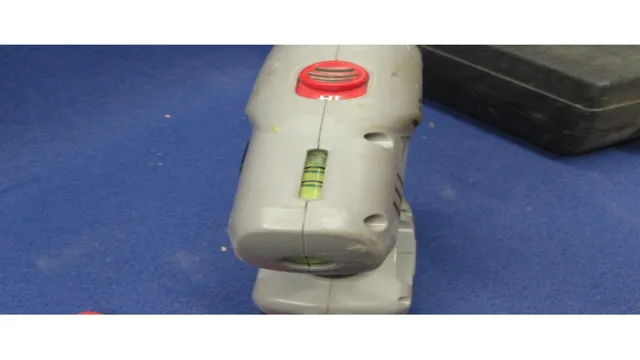Does the Voltage of Cordless Drill Matters? A Comprehensive Guide to Choosing the Right Voltage

When it comes to cordless drills, the question of whether voltage matters can be a perplexing one. With so many options to choose from, it can be overwhelming to determine what voltage is right for your needs. But fear not! In this blog, we’ll dive into the world of cordless drill voltage and provide you with all the answers you need to make an informed decision.
First things first, let’s define what voltage actually means. Voltage refers to the amount of electrical energy that a cordless drill’s battery can deliver. In simpler terms, the higher the voltage, the more power the drill has.
But do you really need a high voltage cordless drill? Well, it depends on what tasks you’ll be using it for. If you’ll mostly be using the drill for small tasks like hanging pictures or assembling furniture, a lower voltage drill (around 12 volts) will likely suffice. However, if you plan on using the drill for heavier tasks like drilling in thick wooden beams or masonry, a higher voltage (18 volts or more) drill will be necessary.
It’s also worth noting that a higher voltage drill will generally have a longer runtime and be able to handle tougher jobs without overheating. So, while a low voltage drill may be cheaper, you may end up needing to replace it sooner if it can’t handle the workload you throw at it. In summary, voltage does matter for cordless drills, but how much voltage you need depends on the tasks you’ll be using it for.
It’s always a good idea to research and compare different models before making a purchase to ensure you’re getting the right drill for your needs. So, what are you waiting for? Let’s get drilling!
Understanding Cordless Drill Voltage
Many people wonder whether the voltage of a cordless drill matters when choosing one to purchase. The answer is yes, the voltage does matter. The voltage of a cordless drill dictates its power output.
A higher voltage will produce more power and allow you to complete tougher jobs. However, a higher voltage may also mean a heavier and more expensive tool. It ultimately depends on your specific needs and budget.
For example, if you are a DIY enthusiast who only needs a drill for basic household tasks, a drill with a lower voltage may suffice. However, if you are a professional who needs to tackle heavy-duty projects on a daily basis, a drill with a higher voltage will be more appropriate. Additionally, it is essential to keep in mind that the battery life of a cordless drill is affected by its voltage.
A higher voltage will drain the battery faster, which means you may need to recharge it more frequently. Thus, it is crucial to consider the battery capacity and charging time when selecting a cordless drill. In conclusion, the voltage of a cordless drill is a crucial factor to consider when purchasing one.
It impacts the power output, weight, price, and battery life of the tool. Make sure to assess your specific needs and budget before choosing a drill with the appropriate voltage for your tasks.
What is Voltage in Cordless Drills?
Voltage in cordless drills is an essential aspect that can determine the tool’s performance and capabilities. Simply put, voltage refers to the electrical power that drives the drill’s motor. A cordless drill’s voltage rating can range from 12V to 20V or higher, and choosing the right voltage rating depends on the type of tasks you need to accomplish.
A higher voltage rating can deliver more power to the drill’s motor, making it suitable for heavy-duty applications such as drilling through steel or concrete. However, higher voltage also means greater weight and bulk, which can make it less convenient for simple tasks. Conversely, a lower voltage rating can handle lighter tasks such as assembling furniture or hanging picture frames, but may struggle under heavy loads.
Therefore, it is essential to choose the right voltage rating that suits your intended applications so you can enjoy optimal performance and efficiency from your cordless drill.

Understanding Voltage Ratings
Cordless drills run on battery power, which means that their voltage rating is essential in determining their performance and capabilities. The voltage rating of a cordless drill battery ranges from 4V to 36V, and each level of voltage provides varying levels of power. For example, a cordless drill with a lower voltage rating is best suited for light-duty tasks such as drilling small holes, while a drill with a higher voltage rating is ideal for heavy-duty jobs such as drilling through thick materials like concrete.
It’s important to note that the higher the voltage rating, the heavier the drill, and the more expensive it will be. It’s important to choose a cordless drill with the appropriate voltage rating based on the tasks at hand to get the most out of your investment.
You May Also Love:
Impact of Voltage on Cordless Drills
When it comes to cordless drills, one of the factors that can impact their performance is the voltage. Generally speaking, the higher the voltage, the more powerful the drill will be. This means that if you’re looking for a drill that can handle tougher tasks, you may want to choose one with a higher voltage.
However, it’s important to keep in mind that voltage alone isn’t the only factor that determines a drill’s capabilities. A lower voltage drill may still be able to handle the tasks you need it for, especially if it’s well-designed and uses high-quality parts. Ultimately, your choice of drill should be based on your specific needs and budget, as well as the features that are most important to you.
So, does the voltage of cordless drill matters? The answer is yes, but it’s not the only thing that matters.
Higher Voltage: More Power
When it comes to cordless drills, voltage is an important factor that can greatly impact its power and performance. Higher voltage means more power, which translates to the ability to tackle bigger and tougher jobs. For instance, a 20V cordless drill will likely have more torque and drilling power than a 12V one.
However, it’s important to keep in mind that higher voltage also means a heavier and bulkier tool, which can make it more difficult to use in tight spaces or for extended periods of time. Additionally, higher voltage often comes with a higher price tag, so it’s important to consider your specific needs and budget before making a decision. Ultimately, it’s important to find the right balance between voltage and other factors such as weight, size, and cost in order to choose the best cordless drill for your needs.
Lower Voltage: Less Demanding Tasks
When it comes to cordless drills, one of the biggest factors that impacts their performance is voltage. The higher the voltage, the more power the cordless drill will have and the more demanding tasks it can handle. On the other hand, lower voltage cordless drills are better suited for less demanding tasks.
While a higher voltage cordless drill might seem like the obvious choice, it’s important to consider what tasks you’ll be using it for. If you’re just doing small DIY projects around the house, a lower voltage cordless drill could be perfect for you. However, if you’re tackling tougher jobs that require drilling through thick materials, then a higher voltage cordless drill is the way to go.
Ultimately, it’s all about finding the right balance between power and capability for your specific needs.
Battery Life and Charging Time
When it comes to cordless drills, the voltage of the battery has a significant impact on the battery life and charging time. Higher voltage batteries generally provide more power, but they also drain quicker and require more time to recharge. For example, a 12-volt battery may take around an hour to fully recharge, while an 18-volt battery may take closer to two hours.
However, the higher voltage battery will generally provide better performance and last longer during use. It’s important to choose the right voltage for your needs and consider how much downtime you can tolerate during recharging. Additionally, using a charger specifically designed for your battery voltage can help maximize its lifespan and efficiency.
Overall, understanding the impact of voltage can help you choose the right cordless drill for your project and ensure you have enough power to get the job done efficiently.
Choosing the Right Voltage for Your Cordless Drill
When it comes to cordless drills, the voltage level is one of the most important factors to consider before making your purchase. So, does the voltage of cordless drill matters? Absolutely! The voltage of a drill determines its power and speed. Generally, the higher the voltage, the more powerful the drill, and the faster it can rotate.
For simple DIY tasks, a drill with a voltage of 12-18 volts is perfect. However, for heavier-duty tasks, look for a drill with a voltage of 20-24 volts. This will ensure that you have enough power and speed to handle even the toughest tasks.
So, before you start shopping for cordless drills, make sure to consider the type of projects you will be using it for, and choose a voltage level that suits your needs.
Application and Intended Tasks
When it comes to choosing the right voltage for your cordless drill, it’s important to consider the application and intended tasks. Lower voltage drills, such as 12V or 18V, are great for light-duty tasks such as hanging pictures or assembling furniture. However, for heavier-duty tasks such as drilling through thick materials or driving long screws, a higher voltage drill such as 20V or 24V may be more appropriate.
It’s important to note that higher voltage drills are often heavier and more expensive, so it’s important to balance your needs with your budget. Ultimately, choosing the right voltage for your cordless drill will ensure efficient and effective performance for all of your DIY projects and tasks.
Experience and Comfort Level
When it comes to cordless drills, choosing the right voltage is crucial. The voltage of a cordless drill refers to the power output it can deliver. The higher the voltage, the more power the drill has.
However, having more power doesn’t necessarily mean it’s the best choice for every user. Experience and comfort level play a significant role in determining the right voltage for your needs. If you’re a beginner or the tasks you’ll be performing are relatively light-duty, a lower voltage drill, such as a 12V or 18V, should suffice.
These drills are lightweight, easy to maneuver, and won’t tire out your arm quickly. However, if you’re an experienced user and work on heavy-duty tasks regularly, a drill with a higher voltage, such as a 20V or 24V, may be more suitable. These drills are more potent, making it easier to drill through tough materials.
Remember, there’s no one-size-fits-all solution when it comes to voltage selection, so choose wisely based on your experience and comfort level.
Final Thoughts
When it comes to cordless drills, the voltage of the tool can make a significant difference in its performance. In general, higher voltage drills will have more power and be able to handle tougher jobs with ease. However, that doesn’t mean that a lower voltage drill can’t get the job done.
It all depends on the types of tasks you’ll be using the drill for. If you’ll be drilling through harder materials like metal or concrete, you’ll likely need a higher voltage drill to get the job done. But if you’re just doing simple DIY projects around the house, a lower voltage option will probably suffice.
It’s important to consider your specific needs and the types of projects you’ll be working on when choosing a cordless drill. While voltage is an important factor to consider, it’s not the only one. Other important features include battery life, size and weight, and overall build quality.
By finding a drill that meets your unique needs, you can ensure that you get the job done quickly and efficiently every time.
Conclusion
In the end, it all comes down to what you need – if you’re a power tool enthusiast who has a lot of heavy-duty projects ahead, a higher voltage cordless drill may be the better choice for you. But if you’re a weekend DIY warrior who just needs to hang up some shelves, a lower voltage drill will do just fine. Whatever your preference, always remember to stay safe while drilling and have fun getting your projects done!”
FAQs
How does the voltage of a cordless drill affect its power?
The voltage of a cordless drill determines its power output. Higher voltage means more power, making it easier to handle tougher jobs.
Can I use a lower voltage battery on my cordless drill?
It’s generally not recommended to use a lower voltage battery on your cordless drill as it may not give enough power to handle the job.
What is the typical voltage range for cordless drills?
The typical voltage range for cordless drills varies from 12V to 20V. However, some high-end models can go up to 36V.
Are cordless drills with higher voltage more expensive?
Cordless drills with higher voltage are generally more expensive as they come with better power and performance capabilities.
Can the voltage on cordless drills be adjusted?
No, the voltage on cordless drills cannot be adjusted. However, some models come with adjustable clutch settings for different speed and torque levels.
Does a higher voltage cordless drill result in decreased battery life?
Higher voltage cordless drills may result in decreased battery life, but this can be offset by using high-capacity batteries.
Can I use a cordless drill with a lower voltage for small DIY projects?
Yes, you can use a cordless drill with a lower voltage for small DIY projects as they usually don’t require as much power as larger jobs.



